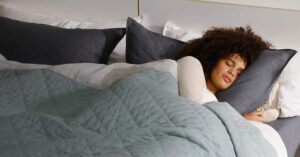How to Wash Pillows
Disclosure: By clicking on the product links in this article, Mattress Nerd may receive a commission fee at no cost to you, the reader. Read full disclosure statement.
Washing your pillows is often overlooked, but is so essential to good sleep health. Just like our sheets and bedding, our pillows collect enormous quantities of dust mites that we shed from our skin every second of the day, including when we sleep. We may not need to wash them as frequently as we need to wash our sheets, but we should know how to tackle this task a few times a year.
Dust mites can cause allergies and many times, those that are allergic to “dust” are actually having reactions to decomposing dust mites and their droppings. Definitely not something I want going on in my pillow. Exposure to dust mites is particularly bad for children, who are more sensitive to allergens around them. If your kids wake up with their eyes watery and have difficulty breathing, there is a good chance that it is due to dust mites.
An unclean pillow can also be a breeding ground for fungi. The thought of breathing that in at night is highly disturbing. Dust mites, oils, bodily fluids, and dandruff can all contribute to a dirty pillow.
Experts say that you should wash your pillows at least twice a year, and we will teach you how to do so properly so that you can get a good night’s sleep without worrying about what could be breeding under your head.
Video Guide: When and How to Wash Your Pillow

How to Wash Pillows
First, remove your pillowcase. If your pillows have additional zip-on cases, remove those as well, they will need to be washed separately. If you have more than one pillow that needs to be washed, put them in the washing machine together! This will help protect them and prevent them from clumping up in the cycle.
A front-loading washing machine is ideal for washing pillows because top-loading washers can be rough on them. The pillows tend to float, and the agitator of a top-load washer can harm them. It might be worth a trip to a laundromat to use a front-loading washer if you are able to get there.
Next, add your detergent. Be sure to use one that is mild enough it will not irritate your skin. Typically I always use the same detergent I use to wash my sheets and bedding, just much less! You only need about one tablespoon per pillow.
Use hot water on a ‘delicate’ or ‘gentle’ setting.
How to Dry Your Pillow
One of the things that may be keeping you from tossing your beloved pillows into the washing machine, is the fear that once they are washed, they will fail to return to their soft, fluffy nature. Fear not! Washing your pillows will not ruin the inside, as long as you follow the proper steps your pillow will come out even better than new.
After your pillows have finished their wash cycle, I like to take them out and shake them a bit to evenly distribute the filling and get rid of any big lumps that may have formed in the washer. Then place them in the dryer. For synthetic and polyester pillows, turn the dryer on low heat. For feather and down pillows use the no heat/air/fluff setting on your dryer.
A trick you can try is to add two tennis balls to the dryer! The tennis balls will help to fluff your pillows and help them to dry more quickly.
It is important to check whether your pillows are dry after they have been tumble dried. Damp pillows will grow mold and mildew, so make sure they get completely dry!
How to Wash Memory Foam Pillows
Memory Foam pillows have their own washing instructions entirely. In most cases, they will need to be washed by hand.
The protective cover of the pillow can often be put in the washing machine, but the physical pillow will do much better if it is spot cleaned by hand. Be sure to read the care instructions
In a tub or sink, plug the drain, and run some warm water mixed with a small amount of detergent. While the water runs, fetch a clean washcloth. Dipping the cloth in the soapy water, you can then scrub or pat the pillow to clean it. Once you are done, rinse the cleaned areas under freshwater, getting out as much soap as possible. Try to avoid saturating the pillow more than you need.
Once they are clean, do not wring the pillows out because they can lose their shape. Instead, hang them in direct sunlight to dry. These pillows do not belong in the dryer, because the high heat will degrade the memory foam.
Make sure the foam is dry. Memory foam is likely to hold onto water for a long time, so make sure it is totally dry before bringing it back to your bed. You don’t want it to mold or mildew.
Check Your Pillow Periodically
You may not appreciate how important your pillow is to your overall health. It should provide the support that helps keep your neck and back in top form. An old pillow could result in poor posture, a bad back, or cricks in your neck.
Pillows are not meant to be kept forever. You should check your pillows to make sure they are still in good condition every now and then. An easy way to check this is to fold them in half and see if they spring back to form. If not, it may be time for you to get new pillows. Also, look for misshapen lumps and whether or not you can still fluff them.
Synthetic pillows typically don’t last as long as feather or down pillows, but make sure that you aren’t allergic to feathers before you buy one! The expert recommendation is to replace your pillow every three years, but it should really depend on what shape the pillow is in. If you are shopping for a new pillow, see our best pillow guide.


